#the mughals
Explore tagged Tumblr posts
Text

Emerald ring, Mughal empire, 16th-17th century
from Christies
3K notes
·
View notes
Text
#InternationalVultureAwarenessDay:

Ustād Manṣūr (India, active 1590-1624)
Red-Headed Vulture and Long-Billed Vulture, c. 1615–20
Mughal, Jahāngīr Studio
folio from the Shah Jahan Album
ink, opaque watercolor, & gold on paper
39.1 x 25.6 cm (15 3/8 x 10 1/16 in)
The Metropolitan Museum of Art, New York 55.121.10.12 verso: https://www.metmuseum.org/art/collection/search/451260
#animals in art#animal holiday#birds in art#bird#miniature painting#Indian art#Mughal art#South Asian art#Asian art#vulture#vultures#birds#pair#Ustad Mansur#17th century art#Metropolitan Museum of Art New York#International Vulture Awareness Day#species ID#Red-Headed Vulture#Long-Billed Vulture
732 notes
·
View notes
Text
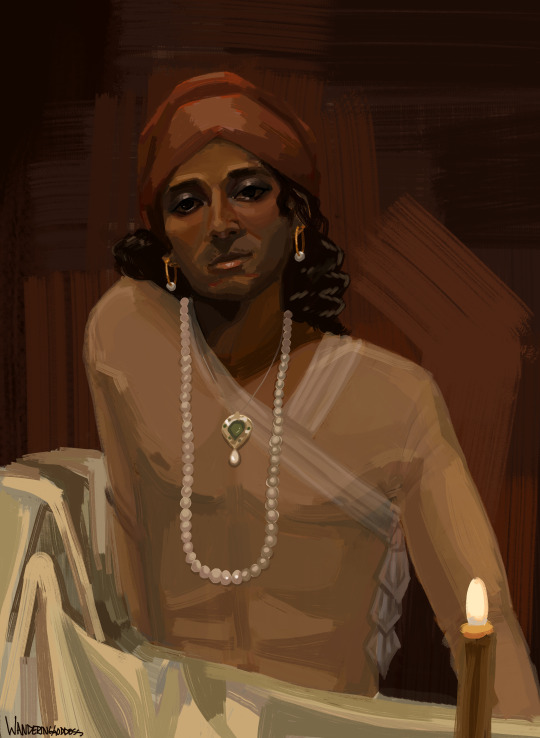
Arun, in Mughal Era dress
(i had fun researching the fashion history so im gonna include a bit of info under the cut for anyone interested!)
First, Armand is dressed more typically for the upper class or royalty, but I wanted to paint him all dolled up. This would have been somewhat typical dress for Mughal Empire (roughly the 16th-18th centuries) royalty. Men of all classes would typically wear the Jama (the overcoat). I depicted this one as made of Dhaka Muslin, one of the finest and rarest fabrics produced from the Dhaka region. The technique has since been lost, but at the time was incredibly sought after. So much so that during the British colonizers would take the artisans and materials and force them into reproducing the fabric for little to know compensation. Dhaka Muslin was so fine that it was practically transparent, and was worn by members of the upperclass across the world. I read somewhere that it was used to dress statues of greek goddesses. Another little detail is that Armand's Jama is fastened to the right, typical of a Muslim man, rather than to the left (a Hindu man).
I based this loosely off of Caravaggio's Bachus and Depictions of Prince Salim.
All the info I got was from these three youtube videos, so it's not like any serious research!
youtube
youtube
youtube
#beloved arun amadeo armand#after doing some research into the culture/dress of the mughal empire it makes armands back story/motivations so much more fascinating#i wanna write essays about him#(if it isn't obvious im in grad school for history and am a major nerd)#iwtv#iwtv art#armand#my art#Youtube
580 notes
·
View notes
Text
Emerald Spectacles from India, c. 1620-1660 CE: the lenses of these spectacles were cut from a single emerald, and the original, uncut stone weighed more than 300 carats
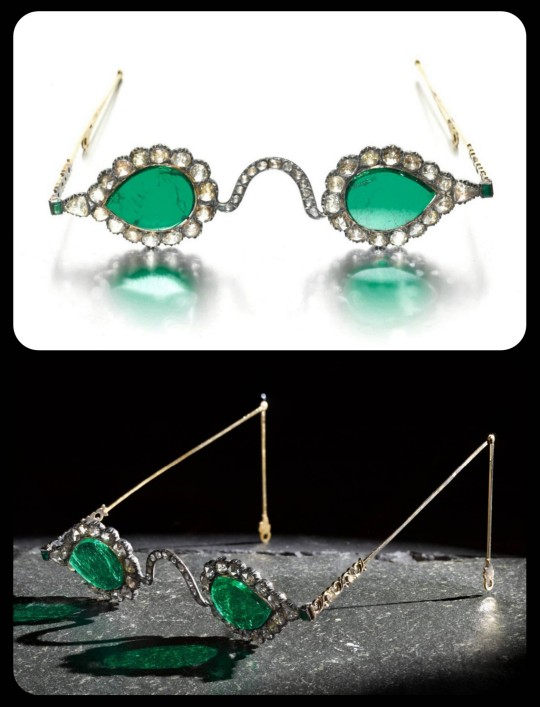
These eyeglasses are also known by the name Astaneh-e ferdaws, meaning "Gate of Paradise," based on the symbolic associations between the color green and the concept of spiritual salvation or "paradise." Those associations, which are rooted in Islamic tradition, were especially common in Mughal India.
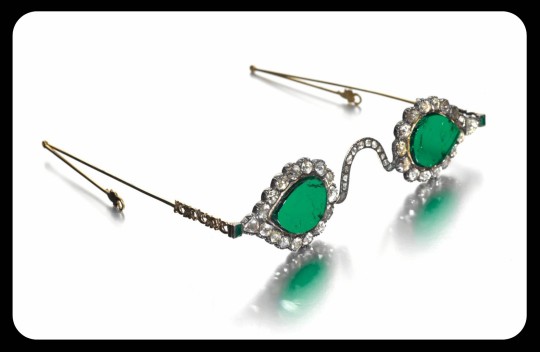
The lenses were crafted from two thin slices of the same emerald. Together, the lenses have a combined weight of about 27 carats, but given the precision, size, and shape of each lens, experts believe that the original emerald likely weighed in excess of 300 carats (more than sixty grams) before it was cleaved down in order to produce the lenses.
The emerald was found at a mine in Muzo, Colombia, and it was then transported across the Atlantic by Spanish or Portuguese merchants.

Each lens is encircled by rose-cut diamonds, which run along an ornate frame made of gold and silver. This diamond-studded frame was installed during the late 1800s, when modern stylistic elements were incorporated into the original pince-nez design.
The "Gate of Paradise" spectacles are often accompanied by a second pair of eyeglasses that were created during the same period, and they were almost certainly commissioned by the same person; these other spectacles are known by the name Halqeh-e nur, meaning "Halo of Light," and they feature lenses that were cleaved from a single diamond.
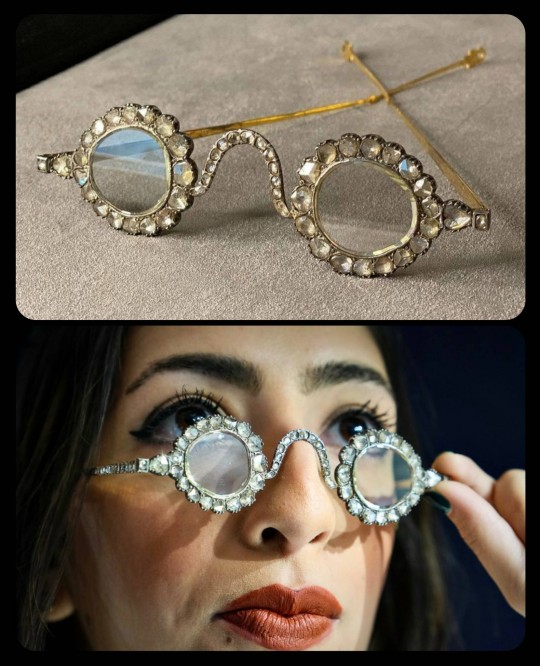
It's estimated that the original, uncut diamond weighed about 200-300 carats, which would make it one of the largest uncut diamonds ever discovered.
The lenses are so clear and so flat that they sometimes seem almost invisible.

Both sets of spectacles date back to the mid-1600s, and it's believed that they were commissioned by a Mughal emperor or prince. The identity of that person is still a bit of a mystery, but it has been widely speculated that the patron was Shah Jahan -- the Mughal ruler who famously commissioned the Taj Mahal after the death of his wife, Mumtaz Mahal. Shah Jahan ruled as the Mughal emperor from about 1628 to 1658.

The emerald and diamond lenses may have served some symbolic, sentimental, or cultural purpose, or they may have been chosen simply because they're pretty and extravagant. Their original purpose and significance remains unclear, but there is evidence to suggest that the spectacles were actually designed to be worn by someone.
Mystical properties have long been attributed to these spectacles; it's believed that they can promote healing, ward off evil, impart wisdom, and/or bring the wearer closer to enlightenment. Those beliefs mostly stem from Indic and Islamic traditions that associate each of the gemstones with specific spiritual qualities. Emeralds are associated with spiritual salvation, healing, cleansing, and eternal life, while diamonds are associated with enlightenment, wisdom, celestial light, and mysticism.
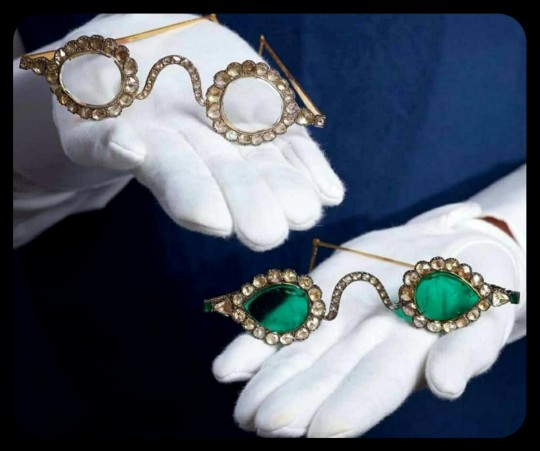
The "Gate of Paradise" and the "Halo of Light" spectacles were both kept in the collections of a wealthy Indian family until 1980, when they were sold to private collectors, and they were then put up for auction once again in 2021. They were most recently valued at about $2 million to $3.4 million per pair.
Sources & More Info:
Sotheby's: Mughal Spectacles
Architectural Digest of India: At Sotheby's auction, Mughal-era eyeglasses made of diamond and emerald create a stir
Only Natural Diamonds: Auspicious Sight & the Halqeh-e Nur Spectacles
The Royal Society Publishing: Cleaving the Halqeh-Ye Nur Diamonds
Gemological Institution of America: Two Antique Mughal Spectacles with Gemstone Lenses
Manuscript: From Satan's Crown to the Holy Grail: emeralds in myth, magic, and history
CNN: The $3.5 million Spectacles Said to Ward off Evil
BBC: Rare Mughal Era Spectacles to be Auctioned by Sotheby's
#history#archaeology#artifact#mughal#india#17th century#art#emerald#diamond#glasses#indian lore#islam#religion#mysticism#indian history#anthropology#spirituality#fashion
5K notes
·
View notes
Text



Embroidered coat, Mughal Indian, ca.1620–25. Victoria and Albert Museum, London
#historical fashion#17th century#1620s fashion#Mughal fashion#Indian fashion#embroidery#coat#paleta post
466 notes
·
View notes
Text
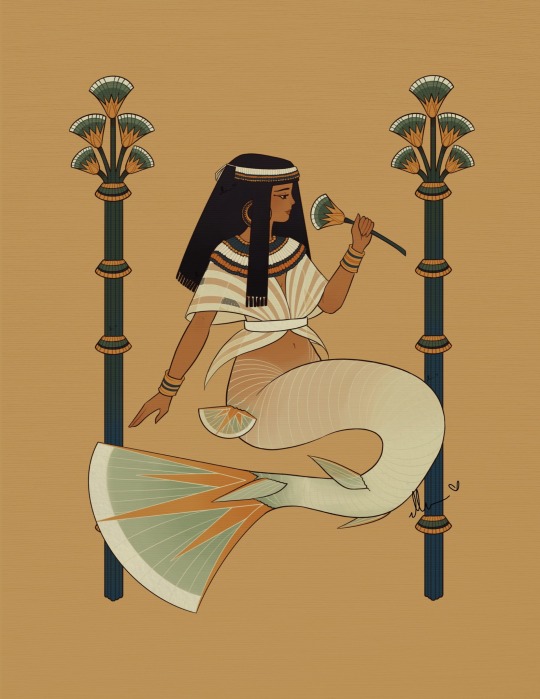


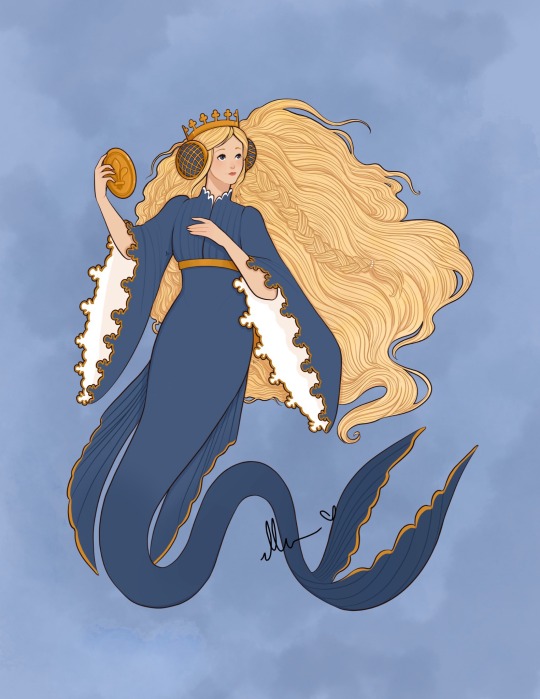




All the Historical Mermay’s together!
I had a lot of fun with this mermay prompt list by chloe.z.arts and they turned into a pretty cool collection of illustrations!
Prompt list by chloe.z.arts on instagram.
I am the artist! Do not post without permission & credit! Thank you! Come visit me over on: instagram.com/ellenartistic or tiktok: @ellenartistic
#historical mermay#mermay 2023#collection of mermaids#lnart#ellenart#historically inspired#historical fashion#it’s gonna be mermay#ancient egypt#ancient greece#tang dynasty#french medieval#italian renaissance#mughal empire#edo period#late victorian era
4K notes
·
View notes
Text

A girl luring quicksilver from a mine by her beauty. India, Mughal dynasty,mid-18th century. Opaque watercolour on paper.
172 notes
·
View notes
Text

The garden of Achabal was developed by Empress Nur Jahan and later by Princess Jahanara. The springs here are housed within a double-height structure and the fountain systems developed here were to become part of the repertoire of later Mughal, Rajput and later provincial gardens across the subcontinent.
Omar Bazaz
108 notes
·
View notes
Text

Gilt silver rosewater sprinkler, Mughal Empire, 17th century
from The Brooklyn Museum
401 notes
·
View notes
Text
#WatercolorWednesday:

Portrait of a Ladakhi Mountain Goat [Changthangi*]
India, Mughal dynasty, c.1601-25
Opaque watercolor, ink, gold on paper
37.9 × 25.6 cm (14 7/8 × 10 1/8 in.)
The Art Institute of Chicago 1919.944: https://www.artic.edu/artworks/76868/portrait-of-a-ladakhi-mountain-goat
🆔 “The Changthangi [aka Changpa, Ladakh Pashmina, Kashmiri] is a breed of cashmere goat native to the high plateaus of Ladakh in northern India. It is closely associated with the nomadic Changpa people of the Changthang plateau….The intense cold of the region causes the goats to grow a thick undercoat, which is harvested to produce the fine pashmina grade of cashmere.”
https://en.wikipedia.org/wiki/Changtha
#IndianArt #SouthAsianArt
#animals in art#painting#Indian art#South Asian art#Asian art#Mughal art#miniature#natural history art#goat#Changthangi#livestock#domesticated animals#watercolor#Watercolor Wednesday#Art Institute of Chicago
682 notes
·
View notes
Text









#anemones by bertha evelyn#bugonastump on ig#mochipanko flower series#Bas Meeuws- Mughal Botanical#stamp#stamps#bugs#flowers#art#aesthetic#pinterest#icons#layout#moodboard#girl blogger#artwork#dark#dark academia#insects
124 notes
·
View notes
Text

#desiblr#desi tumblr#desi teen#desi shit posting#desi tag#desi#desi academia#desi core#hindublr#sam shitposting again#mughal memes#mughal#india#indian history
77 notes
·
View notes
Text

A composite mail and plate armor, South India, 16th-17th century, from Olympia Auction House.
267 notes
·
View notes
Text
I MADE AN OC FOR ALL 15 FEARS AND IM INSUFFERABLE ABOUT IT real not clickbait

yes theres 16 people here that is because i had an eye duplicate on accident ok? (closeups below)
anyway back in (checks watch) august??? 2024 i got bored and went hey what if i made an oc for every fear and then i did and only now have i drawn them all? some preexist (isfahan, ghuraba, victoria, santi/hermes/marina) but the rest of them did not and i love them all
my askbox is open if youd like to know more (i say, wearing an obnoxiously large 'ask me about my freaks' tshirt)
closeups incoming












#the magnus archives#tma#tma podcast#magpod#tma oc#tma ocs#isfahan mughal laika oc#laika fear of flying tma#ghuraba fakhoury laika oc#gail byrne laika oc#roman cassis laika oc#maria clarke laika oc#david reis laika oc#isabella hopkins laika oc#victoria galanis laika oc#violetta and sully wilson laika oc#laika santiago vitar#hermes dillon laika oc#marina ibrahimovic laika oc#uriah thompson laika oc#danys yvesmark-laguerre laika oc#rina ingrams laika oc#naoya akamine “the ballerina” laika oc#tma fanart#tma art
80 notes
·
View notes
Text

Self-portrait (opaque watercolor, gold, and ink on paper) of Mir Sayyid Ali (ca. 1510-1572), executed between 1555 and 1556. Ali, from present-day Iran, was active as a miniature painter in the Mughal Empire of India and is credited with helping develop the distinctive Mughal style of painting. This self-portrait is now in the Los Angeles County Museum of Art, Los Angeles, CA, USA. Photo credit: LACMA.
#art#art history#Mir Sayyid Ali#Mughal Empire#Islamic art#Mughal art#Persian art#South Asian art#portrait#portrait painting#portraiture#self-portrait#16th century#16th century art#Los Angeles County Museum of Art#LACMA
73 notes
·
View notes
Text

A dervish wandering in a landscape with a dog Mughal, first half of the 17th Century
Gouache on paper
Bonhams
78 notes
·
View notes